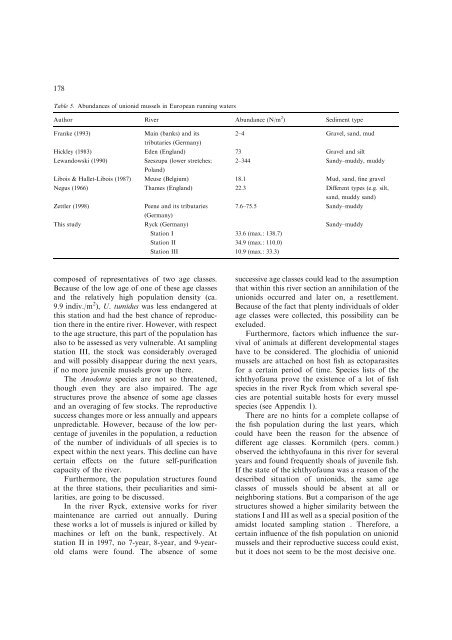Population size and structure of three mussel species (Bivalvia ...
Population size and structure of three mussel species (Bivalvia ...
Population size and structure of three mussel species (Bivalvia ...
Create successful ePaper yourself
Turn your PDF publications into a flip-book with our unique Google optimized e-Paper software.
178<br />
Table 5. Abundances <strong>of</strong> unionid <strong>mussel</strong>s in European running waters<br />
Author River Abundance (N/m 2 ) Sediment type<br />
Franke (1993)<br />
Main (banks) <strong>and</strong> its<br />
2–4 Gravel, s<strong>and</strong>, mud<br />
tributaries (Germany)<br />
Hickley (1983) Eden (Engl<strong>and</strong>) 73 Gravel <strong>and</strong> silt<br />
Lew<strong>and</strong>owski (1990)<br />
Szeszupa (lower stretches; 2–344 S<strong>and</strong>y–muddy, muddy<br />
Pol<strong>and</strong>)<br />
Libois & Hallet-Libois (1987) Meuse (Belgium) 18.1 Mud, s<strong>and</strong>, fine gravel<br />
Negus (1966) Thames (Engl<strong>and</strong>) 22.3 Different types (e.g. silt,<br />
s<strong>and</strong>, muddy s<strong>and</strong>)<br />
Zettler (1998)<br />
Peene <strong>and</strong> its tributaries 7.6–75.5 S<strong>and</strong>y–muddy<br />
(Germany)<br />
This study Ryck (Germany) S<strong>and</strong>y–muddy<br />
Station I 33.6 (max.: 138.7)<br />
Station II 34.9 (max.: 110.0)<br />
Station III 10.9 (max.: 33.3)<br />
composed <strong>of</strong> representatives <strong>of</strong> two age classes.<br />
Because <strong>of</strong> the low age <strong>of</strong> one <strong>of</strong> these age classes<br />
<strong>and</strong> the relatively high population density (ca.<br />
9.9 indiv./m 2 ), U. tumidus was less endangered at<br />
this station <strong>and</strong> had the best chance <strong>of</strong> reproduction<br />
there in the entire river. However, with respect<br />
to the age <strong>structure</strong>, this part <strong>of</strong> the population has<br />
also to be assessed as very vulnerable. At sampling<br />
station III, the stock was considerably overaged<br />
<strong>and</strong> will possibly disappear during the next years,<br />
if no more juvenile <strong>mussel</strong>s grow up there.<br />
The Anodonta <strong>species</strong> are not so threatened,<br />
though even they are also impaired. The age<br />
<strong>structure</strong>s prove the absence <strong>of</strong> some age classes<br />
<strong>and</strong> an overaging <strong>of</strong> few stocks. The reproductive<br />
success changes more or less annually <strong>and</strong> appears<br />
unpredictable. However, because <strong>of</strong> the low percentage<br />
<strong>of</strong> juveniles in the population, a reduction<br />
<strong>of</strong> the number <strong>of</strong> individuals <strong>of</strong> all <strong>species</strong> is to<br />
expect within the next years. This decline can have<br />
certain effects on the future self-purification<br />
capacity <strong>of</strong> the river.<br />
Furthermore, the population <strong>structure</strong>s found<br />
at the <strong>three</strong> stations, their peculiarities <strong>and</strong> similarities,<br />
are going to be discussed.<br />
In the river Ryck, extensive works for river<br />
maintenance are carried out annually. During<br />
these works a lot <strong>of</strong> <strong>mussel</strong>s is injured or killed by<br />
machines or left on the bank, respectively. At<br />
station II in 1997, no 7-year, 8-year, <strong>and</strong> 9-yearold<br />
clams were found. The absence <strong>of</strong> some<br />
successive age classes could lead to the assumption<br />
that within this river section an annihilation <strong>of</strong> the<br />
unionids occurred <strong>and</strong> later on, a resettlement.<br />
Because <strong>of</strong> the fact that plenty individuals <strong>of</strong> older<br />
age classes were collected, this possibility can be<br />
excluded.<br />
Furthermore, factors which influence the survival<br />
<strong>of</strong> animals at different developmental stages<br />
have to be considered. The glochidia <strong>of</strong> unionid<br />
<strong>mussel</strong>s are attached on host fish as ectoparasites<br />
for a certain period <strong>of</strong> time. Species lists <strong>of</strong> the<br />
ichthy<strong>of</strong>auna prove the existence <strong>of</strong> a lot <strong>of</strong> fish<br />
<strong>species</strong> in the river Ryck from which several <strong>species</strong><br />
are potential suitable hosts for every <strong>mussel</strong><br />
<strong>species</strong> (see Appendix 1).<br />
There are no hints for a complete collapse <strong>of</strong><br />
the fish population during the last years, which<br />
could have been the reason for the absence <strong>of</strong><br />
different age classes. Kornmilch (pers. comm.)<br />
observed the ichthy<strong>of</strong>auna in this river for several<br />
years <strong>and</strong> found frequently shoals <strong>of</strong> juvenile fish.<br />
If the state <strong>of</strong> the ichthy<strong>of</strong>auna was a reason <strong>of</strong> the<br />
described situation <strong>of</strong> unionids, the same age<br />
classes <strong>of</strong> <strong>mussel</strong>s should be absent at all or<br />
neighboring stations. But a comparison <strong>of</strong> the age<br />
<strong>structure</strong>s showed a higher similarity between the<br />
stations I <strong>and</strong> III as well as a special position <strong>of</strong> the<br />
amidst located sampling station . Therefore, a<br />
certain influence <strong>of</strong> the fish population on unionid<br />
<strong>mussel</strong>s <strong>and</strong> their reproductive success could exist,<br />
but it does not seem to be the most decisive one.
















